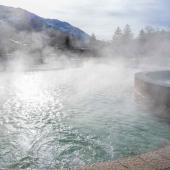The Gem of Montana: Yogo Sapphires
Sapphires can be found in many places throughout the world, including such exotic locales as Sri Lanka and Kashmir, but one of the finest and most ardently sought-after varieties comes from right here in the Treasure State. Of the several different types of sapphires found in Montana, the most famous and desirable variety is the world-famous Yogo sapphire, a gem with a color of deep, mesmerizing, cornflower blue.
The word “sapphire,” in fact comes from the Greek word sappheiros, which means “blue stone,” though scholars think that the Greek word originally referred rather to lapis lazuli, and the stone that we now call the sapphire the Greeks called hyakinthos, a word that similarly suggests blue as indicated in the hyacinth blossom.
Gemologists explain that sapphires are actually an extremely hard mineral called corundum that can occur in a variety of colors, all of which are called sapphire except those that are colored red: red corundum goes by the name ruby. The diamond reigns as the supreme mineral on the hardness scale, but the sapphire is close behind it in third place: diamonds rate 10 on the Mohs’ Hardness Scale; sapphires rate 9 (a mineral called moissonite falls between them at 9.5).
Gems are considered precious in part because of their hardness, which makes them impervious to being scratched or marred—except by a harder mineral. But more important than hardness, people prize and collect gems such as sapphires for two other reasons: rarity and beauty. Sapphires, like diamonds, are exceedingly rare, and they possess a naturally sparkling beauty. And while almost any sapphire will draw a person’s attention, Yogo sapphires from the Judith Basin country in Montana are renowned as among the finest examples in the world.
Sapphires from around the world and from other parts of Montana range in color from yellow and pink to green and purple. The specimens produced in Yogo Gulch, an otherwise unremarkable patch of Montana landscape near Utica, Montana, captivate collectors because of their rich blue hue from the hills of the Little Belts.

The cornflower blue Yogo sapphires are popular with jewelry makers, including Tiffany & Co., and Yogo gems have even earned entry into the permanent collection at the Smithsonian Institution, which houses a 10.2-carat stone that is likely the largest Yogo sapphire ever cut.
Geologists are unsure precisely why the sapphires found in the Yogo district are primarily a deep blue while gems found in other areas, such as along the Missouri River north or east of Helena, or near Rock Creek west of Philipsburg tend to be different colors or much lighter shades of blue. But the assumption is that sapphires get their color from impurities in the mineral corundum (Aluminum oxide) as it forms in cooling metamorphic rock. Metamorphic rock, you will recall from high school geology, develops from older rock that is pushed back down toward the mantle, where it is re-melted, a process that can dramatically change its crystalline structure.
As those crystals of sapphire are forming, their color will vary according to which metals happen to be present in the vicinity. If there’s iron around, for example, the sapphire is likely to be yellow. If there’s titanium or vanadium nearby to work its way into the crystals, a darker sapphire is likely to develop. And because corundum tends to form in igneous rock—the kind that oozes from active volcanoes—the purest and brightest sapphires develop from igneous rocks that were reheated. Yogo sapphires formed some 450 million years ago. The size of the sapphires depends on the rate at which the reheated rock cools: the slower the cooling, the larger the gem. As Richard Gibson, a geologist from Butte puts it, “Yogos result from the luck of geology—just the right elements and just the right cooling history making a “Goldilocks” gem that is just about perfect.”
When the gold prospectors came through Montana starting in the early 1860s, they often encountered sapphires in their pans. Because they were fixated on finding the heavy nuggets of yellow metal that meant a quick fortune, for the most part miners regarded the gems as a curiosity more than anything else. All that changed in 1895, however, when Jake Hoover sold a handful or two of the little blue stones he’d found on a gold claim he was working in Yogo Gulch to Tiffany & Co. for $3750, a sum equivalent to about $100,000 in 2018. According to Gibson, a fellow named George F. Kunz , a gemologist who worked for Tiffany, had an inkling of the Yogo treasure for a while leading up to Hoover’s discovery. Kunz had written a book, in fact, called Gems and Precious Stones of North America (1890) in which he discussed the lower-quality specimens found elsewhere along the Missouri. Hoover eventually sold the claim on which he had originally hoped to find gold for $5000, but British financiers who recognized its value as a sapphire producer soon acquired the property at a price of $100,000—that would be $2.8 million in today’s money.
Yogo sapphires are certain to increase in value and collectability in the future for a number of reasons, but chief among them is their naturally acquired blue color. As it happens, ordinary sapphires may be altered in color by subjecting them to sustained heat, but the artificially colored gems are not nearly as valuable. In fact, industry experts estimate that around 95% of all marketplace sapphires have been heat-treated, which drives up the value of naturally blue Yogo gems. It is true that Yogo sapphires tend to be smaller than their counterparts found elsewhere, but the purity of their cornflower color more than makes up for their size. And when a Yogo stone is large enough to yield a large cut gem—watch your pocketbook! While modest stones of less than a quarter carat can be had at reasonable prices beginning at $300, a full carat-cut gem can range as high as $10,000. A carat, incidentally, is a unit of weight equivalent to about 1/140 of an ounce.
Stacy Henry at Barnes Jewelry in Helena emphasized that the value and price of Yogo sapphires really depends on several factors, all of which must be taken into account in trying to locate the specific stone you might want. Presently, for example, Barnes has in its inventory a full one carat Yogo in a vintage ring that is priced at $14,000, while a more modest pendant of a half carat is only $2,200. “The pendant stone has an inclusion,” Henry said, “which affects the value of the stone.”
Almost any jeweler in Montana will tell you that the experts on Yogo sapphires are the folks at the Gem Gallery in Bozeman, which specializes in Yogos. “When it comes to Yogo sapphires, we like to say that ‘we have something for everyone,’” said April Mize at the Gem Gallery. “We sell the popular Montana state pendant which features modest Yogo sapphires, beginning at around $300.” That pendant was designed by Jason Baide, a 2018 graduate of MSU and the son of Gem Gallery owner Don Baide. The Gem Gallery has also marketed some of the most expensive and impressive Yogo sapphires ever discovered: a 3.72 carat stone sold a few years ago for $170,000—just the gem, not including a setting.
It’s hard to appreciate a gem like the sapphire until you actually see one up close and revel in the almost otherworldly depth of its blue color. It’s fitting that the Yogo is found only in Montana, because like the expansive blue skies for which the state is so well known, the singular blue of a Yogo sapphire adds to Montana’s signature mystique.

In January, 1984, four local residents, Lanny Perry, Chuck Ridgeway and their spouses, Joy and Marie, followed a wood cutting trail in the Little Belt Mountains on land once inhabited by the Piegan Blackfeet. The trail led them to a dike section that had been disregarded as not worth mining. They staked their own claims on the property and began to mine. This new area was called the Vortex Mine, and the mining was to be done underground. In time, they sank a shaft and discovered two different veins of Yogo-bearing ore.
In 2005, Alaskan gold miner Mike Roberts was offered a trade. Lanny Perry, who now owned the mine, said he’d swap it straight across for Roberts’ gold mine outside of Fairbanks. Done deal. Mike worked diligently in the mine reaching a depth of over 400 feet, all the while following a strong vein of Yogo sapphires. Tragically, on March 19th, 2012, Mike Roberts died in an accident while working underground in the mine.
In August of 2017 Don Baide, owner of Bozeman’s Gem Gallery, purchased the Vortex Claim and mining equipment from Mike’s widow, Laurie. Work proceeded with the forest service and state mine officials on achieving high code and safety standards. This summer of 2018 is the first mining season under new ownership.
The Vortex Mine is a hard rock, drill and blast operation, working at the 400 ft level. The new owners are exploring sections of the mine through new technology to extract Yogos from areas previously not able to be extracted.












Leave a Comment Here